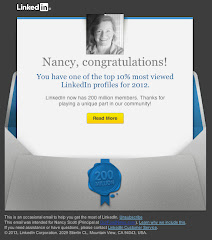For the past few weeks, I’ve been working on the “Year Ahead” issue of Marketing AdVents published by DMAW, so I'm focused on industry trends. Six developments seem to be top of mind these days, but before I get to that, here’s a general observation based on nothing but chatter and intuition:
Things are moving out there in Direct Marketing Land. Over the past year, we’ve seen a lot of company mergers and “affiliations,” especially on the production side of things. Along with that movement, there’s been a whole lotta job switching. For awhile, it was mostly people looking; lately it seems to be people finding. That’s good news. Motion is picking up, so let’s hope it’s not just a random windstorm, shakey, shakey,* Now, to the prognostications:
1. QR Code Explosion. These little roadmaps to wherever are going to dot.dot the landscape next year, as marketers find ever more clever ways to use them. Put them on event promotions, business cards, marketing collateral, even p-URLs. About a year ago, Dana Oshiro suggested applying these to SWAG and self-branding, geo-based reviews and tours, ticketing and registration, and private “acts of defiance.” The construction industry has more applications, here. From the marketer’s perspective, check-out Joey Tanny’s post on Sparksheet (and don’t miss the comments). BOOM!
2. Icky Picky Mail. As postal rates go north, direct mail gets costlier, which means marketers will get more careful, targeted, relevant, creative, tested, and measured. Dave Lewis, DM guru and VP at ProList, came up with this terrific idea: Send a marketing email before you do your direct mail if you have email addresses. If a prospect clicks through to your landing page off of the email, delete them from the direct mailing. You already got their response. It’s that brand of icky picky that will make direct mail keep on keeping on. Thanks, Dave.
3. Direct Marketing and Social Media Integration. Cross media is all over the marketing Net, but strategic integration of social media into direct mail, email, pURLs, and telemarketing is less common. In fact, this study reports that 88% of social media spend is to solidify customer loyalty. But that is now and this is when. Jeffrey Stewart talked about social integration at the 2009 PODi AppForum, so the concept by no means new. However, social media nailed its place in marketing budgets this year, so integration is sure to follow in 2011 (as will positive results).
4. Email Is NOT for Everyone. I’m not saying email marketing is “dead” (though I hear there are obituaries on ice), but I am saying people really are buried in the email avalanche. Fellow blogger Leo Babauta, Zen Habits, sent a “Dear friends,” email that simply said, “I’m giving up on email. It’s just been too much, and I’ve decided I need to focus my life on creating rather than constantly answering emails.” Bottom line, three words: Opt-in only.
5. IMB Innovations. I already blogged at Digital Nirvana about my annoying and super-hyper personalized email marketing experience with Harry and David. But there’s one thing I loved. H&D sent my email the day after their catalog dropped. How did they know? Intelligent Mail barcode, of course. I’ve no doubt smart marketers will find even more intelligent ways to make this barcode shimmy.
6. Ever More Personal p-URLS. Currently, most personalized landing pages (p-URLs) feature a person’s name and maybe some stuff related to the offer that drove them to the page. What if we got really personal -- as personal as we are able to get in our digital direct mail – and then added hyper targeted links, images, and cross-sells to our customized landing page visitors? Too expensive? Hmmm… now that depends, doesn’t it. Shall we test?
p.s. *Thank you, Allstate, for GREAT copywriting and a tip of the windblown hat to Dean Winters.
-- scrubbed by Marketing Brillo
